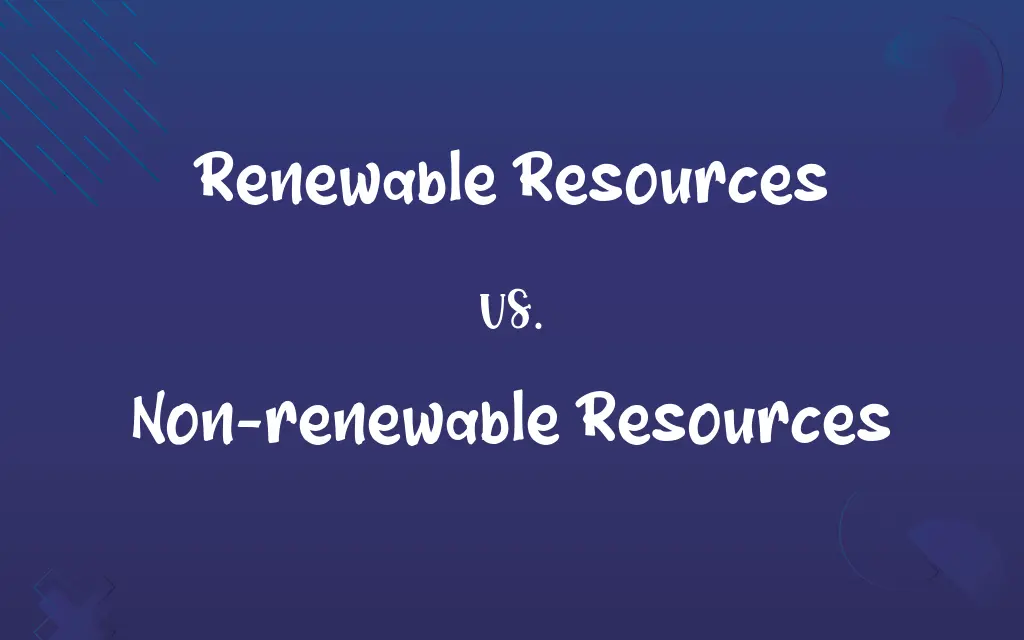Renewable Resources vs. Non-renewable Resources: Know the Difference

By Shumaila Saeed || Published on January 28, 2024
Renewable resources can be replenished naturally over time, like solar energy, while non-renewable resources are finite, like fossil fuels.

Key Differences
Renewable resources are naturally replenishing resources, such as solar, wind, and hydro energy, which can be used repeatedly and sustainably. Non-renewable resources, like coal, oil, and natural gas, are finite and deplete over time, as they do not naturally replenish at a sustainable rate.
Shumaila Saeed
Jan 28, 2024
The use of renewable resources generally has a lower environmental impact, as they produce less pollution and are sustainable long-term. Non-renewable resources, however, often contribute to environmental degradation, including pollution and greenhouse gas emissions, due to their extraction and usage.
Shumaila Saeed
Jan 28, 2024
Renewable resources, such as biomass and geothermal energy, are often dependent on specific climatic or geographical conditions for efficiency. Non-renewable resources, like minerals and metals, are extracted from the earth and are limited by geographical distribution and availability.
Shumaila Saeed
Jan 28, 2024
The technology for harnessing renewable resources, including solar panels and wind turbines, has been advancing, reducing costs and increasing efficiency. In contrast, extracting non-renewable resources, such as oil drilling and mining, becomes more challenging and expensive as these resources become scarcer.
Shumaila Saeed
Jan 28, 2024
Renewable resources can provide a sustainable source of energy and materials with ongoing innovation and investment. Non-renewable resources, while currently central to many economies, face challenges of depletion and increasing environmental and economic costs.
Shumaila Saeed
Jan 28, 2024
ADVERTISEMENT
Comparison Chart
Replenishment
Naturally replenishing over time.
Finite and deplete over time.
Shumaila Saeed
Jan 28, 2024
Environmental Impact
Generally lower impact, more sustainable.
Often higher environmental degradation.
Shumaila Saeed
Jan 28, 2024
Dependency
Dependent on climatic/geographical conditions.
Limited by geographical distribution.
Shumaila Saeed
Jan 28, 2024
Technological Advancement
Advancing rapidly, becoming more efficient.
Becomes more challenging and expensive.
Shumaila Saeed
Jan 28, 2024
Long-term Sustainability
Sustainable and continuously available.
Faces challenges of depletion and costs.
Shumaila Saeed
Jan 28, 2024
ADVERTISEMENT
Renewable Resources and Non-renewable Resources Definitions
Renewable Resources
Resources that regenerate and can be sustainably harvested, like timber from managed forests.
Managed forests provide timber, a renewable resource, without depleting forest reserves.
Shumaila Saeed
Jan 08, 2024
Non-renewable Resources
Earth-derived materials that are depleted through extraction and usage, like uranium.
Uranium, used in nuclear power, is a non-renewable resource with limited reserves.
Shumaila Saeed
Jan 08, 2024
Renewable Resources
Energy sources that are continually replenished, like geothermal and hydroelectric power.
Geothermal energy, a renewable resource, is used to heat homes in some regions.
Shumaila Saeed
Jan 08, 2024
Non-renewable Resources
Energy sources that are used faster than they are formed, such as fossil fuels.
Fossil fuels, including petroleum, are non-renewable resources contributing to greenhouse gas emissions.
Shumaila Saeed
Jan 08, 2024
Renewable Resources
Resources that can be used repeatedly without causing depletion, such as biomass.
Biomass is a renewable resource that can be converted into biofuel.
Shumaila Saeed
Jan 08, 2024
ADVERTISEMENT
Non-renewable Resources
Finite resources that exist in limited quantities on Earth, such as coal and natural gas.
Coal, a non-renewable resource, has been used for electricity generation for decades.
Shumaila Saeed
Jan 08, 2024
Renewable Resources
Resources that can be replenished naturally in a short period of time.
Solar energy is a renewable resource that reduces our dependency on fossil fuels.
Shumaila Saeed
Jan 08, 2024
Non-renewable Resources
Resources that cannot be regenerated or are exhaustible, like certain minerals.
Rare earth minerals, essential for electronics, are non-renewable resources.
Shumaila Saeed
Jan 08, 2024
Renewable Resources
Natural resources that are inexhaustible, like wind and sunlight.
Wind turbines harness wind energy, a powerful renewable resource.
Shumaila Saeed
Jan 08, 2024
Non-renewable Resources
Resources that do not replenish at a sustainable rate, like crude oil.
Crude oil, a non-renewable resource, is a major fuel source for transportation.
Shumaila Saeed
Jan 08, 2024
Repeatedly Asked Queries
Why are renewable resources considered sustainable?
They can be used continuously without depleting, making them sustainable for long-term use.
Shumaila Saeed
Jan 28, 2024
Why are non-renewable resources widely used?
They have been the basis of industrial development and are often energy-dense and convenient.
Shumaila Saeed
Jan 28, 2024
What makes non-renewable resources finite?
They exist in limited quantities and are depleted as they are used.
Shumaila Saeed
Jan 28, 2024
Are all non-renewable resources fossil fuels?
No, they also include minerals and other Earth-derived materials.
Shumaila Saeed
Jan 28, 2024
What are renewable resources?
Resources that can naturally replenish over time like solar, wind, and hydro energy.
Shumaila Saeed
Jan 28, 2024
What are non-renewable resources?
Finite resources that do not replenish sustainably, like fossil fuels and minerals.
Shumaila Saeed
Jan 28, 2024
Can renewable resources ever run out?
Generally, they do not run out as they are naturally replenished, though their availability can vary.
Shumaila Saeed
Jan 28, 2024
How do renewable resources impact the environment?
They typically have a lower environmental impact compared to non-renewable resources.
Shumaila Saeed
Jan 28, 2024
What is an example of a renewable resource?
Solar energy is a key example of a renewable resource.
Shumaila Saeed
Jan 28, 2024
Can the use of renewable resources reduce carbon emissions?
Yes, as they often produce less greenhouse gases compared to fossil fuels.
Shumaila Saeed
Jan 28, 2024
What are the challenges with non-renewable resources?
They pose environmental risks and face depletion concerns.
Shumaila Saeed
Jan 28, 2024
Do non-renewable resources provide more energy than renewables?
They can be more energy-dense, but renewables are catching up in efficiency.
Shumaila Saeed
Jan 28, 2024
Are renewable resources more expensive than non-renewable?
Initially they can be, but costs are decreasing and they become more economical over time.
Shumaila Saeed
Jan 28, 2024
What happens when non-renewable resources are exhausted?
It leads to scarcity, increased prices, and a need to switch to alternative sources.
Shumaila Saeed
Jan 28, 2024
Is there a global shift towards renewable resources?
Yes, there is a growing shift towards renewables for environmental and sustainability reasons.
Shumaila Saeed
Jan 28, 2024
Is water a renewable resource?
Yes, but its availability can be affected by factors like climate change and overuse.
Shumaila Saeed
Jan 28, 2024
Can technology advancement make renewable resources more viable?
Yes, technological improvements enhance efficiency and reduce costs of renewables.
Shumaila Saeed
Jan 28, 2024
How do renewable resources benefit the economy?
They can provide long-term economic benefits through sustainable energy and material supply.
Shumaila Saeed
Jan 28, 2024
What is the main disadvantage of non-renewable resources?
Their finite nature and environmental impact.
Shumaila Saeed
Jan 28, 2024
Is nuclear energy renewable or non-renewable?
Non-renewable, as it relies on finite uranium resources.
Shumaila Saeed
Jan 28, 2024
Share this page
Link for your blog / website
HTML
Link to share via messenger
About Author
Written by
Shumaila SaeedShumaila Saeed, an expert content creator with 6 years of experience, specializes in distilling complex topics into easily digestible comparisons, shining a light on the nuances that both inform and educate readers with clarity and accuracy.








































































